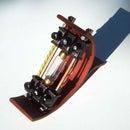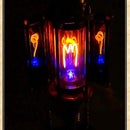Introduction: High Voltage Power Supply for Nixies, CFL, Neon-Glow-Bulbs Etc. for My Steampunk Objects
Hi everybody
This instructable is also a summary of my own experiances in constructing funky light objects using the electronic from a disposal camera, as the knowledge of other projects and constructive ideas from the internet.
So it was my aim to write an clear DIY :-)))))) tutorial which can be followed by everyone who tries to do it for him- (her)self.
Before I started my instructable career, I was looking severeal times in the internet and found a lot of similiar projects which worked with this electronic. There was only one problem to me because nearly all of them had one common mistake: You never saw where to solder exactly the last wire to finish the project successfull!
That´s why I sat down and tried to find out my own best solution. I have to say that I´m not really good in working with electronics and I also can not draw the circuit of the used electronic from the disposal camera but I can show you now exactly where you have to solder your wires to light a flickering candle bulb, a cfl-tube , NIXIE-tube or a Neon Glow Bulb with only using a 1.5 Volts battery. I tested a lot of different disposal camera types (Agfa, Kodak, Fujii) and came to the conclusion that the ones from Fujii work best. Since then I always use only the electronics from Fujii-disposal cameras.
And now here comes my solution in which way I use to work with and I hope that will answer most of your questions about it.
If you follow carefully myt really detailed step by step instructabble, you should get an impressive result.
Before you start please notice two things:
First: There exist two different types of disposal camera s from Fujii which I used: One is driven by an AAA-battery and the other one uses an AA-battery. I call them the "AA-Type" and the "AAA-Type".
Second: Don´t wreck your health and please obay the follwing advices:
***Disclaimers***This instructable works with voltages in excess of 250V. This is more than enough to give you a potentially fatal electric shock if handled incorrectly. If you are unfamiliar with how to work with high voltage, please refrain from performing this instructable. Exercise caution throughout the following steps to avoid electrical dangers and also use insulated tools like pliers and screwdrivers and so on.
If you choose to undertake this instructable, you do so at your own risk.
Please obey that most of the gasfilled CFL-Tubes also contain some Quicksilver (Hg). Dont break them!!!
This instructable involves soldering. A soldering iron becomes very hot during its use, to the point where it can cause instant second-degree burns. Exercise caution throughout the following steps to avoid burns. If you choose to undertake this instructable, you do so at your own risk.
Step 1: How to Get the Electronic From the Disposal Camera (AA-Type)
I start the description with the AA-Type which I prefer because to me it seems to have more possibilities.
First you have to cut of the paper. Then you open the plastic part of the camera´s bottom to take the AA-battery out and then open the camera carefully.Then you can take out the electronic easily.
Step 2: Running Down the Capacitor
In this step, and this is the most dangerous one, you have to run down the big capacitor to avoid any electric danger. I took an High performance resistor with 500 Ohms, twisted two wires on its ends and covered it in a steampunk tube. Then I insulated the ends of the wires too!
(-You can also do this step by taking an big screwdriver with an very good insulated holder but then you risk an loud spark when you get in contact with both pins of the capacitor.)
I prefer the 500 Ohms way;-))))
After running down the capacitor which lasts only some seconds, take an side cutting plier and cut both pins of he capacitor an put it away.
Now your electronic is safe until you start to switch on the electricity again.
Step 3: How to Get the Electronic From the Disposal Camera (AAA-Type)
As you have seen before I´ll show you now hwo t get the electronic from the other type of the Fujii disposal camera (AAA-Type). Some parts are different to the AA-Type and that is why I show it here once again step by step.
The main difference is the "copper blade switch" which is soldered on the electronic. You will desolder it later, see next step.
Step 4: Put Out the Other Electronic Parts You Do Not Need Anymore
This following step is independend from the Type you take, because the parts you have to put out by cutting with a pliers or using a soldering stick are the same.
From both types the big capaicitor is already cut off.
Then you take away the flash module, the switches left on the electronic and if you yu do not want to use them the former red diode light. At the AA-type this light (showed that the flash was ready to shot) sometimes had been a neon glow bulb and somtimes a low voltage diode. At the AAA-type this light is always a low voltage diode!
Step 5: Desolder the Following Parts
Some parts have to be soldered out as the better way. First yo desolder the copper blade switch on the electronic of an AAA type because at this contacts you can solder the wires of the new switch or fix a wire bridge there if you like to place the switch in the wire of the low voltage side (to battery).
I will show this varieties later on ;-)))
I experienced that it is much better to desolder the battery holder parts from the electronic and use a new batteryholder bevause the following reasons:
First:- You can put the changed electronic in an insulating can.
Second:- You can run the AA-Type electronic for example with two AA batteries (3,0 Volts instead of 1,5 Volts) and therefore you need a new holder.
Third:- If you want to changfe battery you can do it without getting in contact with the high voltage parts of the electronic (its already insulated in a PE-can). This avoids electric shocks!!
Step 6: New Power Supply
Now there are some possibilities for a new power supply:
The AAA-type runs best with 1,5 Volts (using 3,0 Volts will kill the transistor soon!!!). The AA-type can either get 1,5 or 3,0 Volts becuase the central transformer is modified in anohter (better) way as at the AAA-type electronic.
Which way of supply (1,5Volts or 3,0 Volts) is the best ,depends on what sort of light do you choose. I will explain thie´s fact later more detailed;-))))
Step 7: The New On/Off Switch-possibilities
Ok.Now it´s the time to start with your mdifications:
First you should test wether your work before was successful and that the electronic still works. The easiest wayt o check it is to clip a wire as a bridge and put inthe battery. If the diode/light glows everything is good. These two contacts where you placed the clip are also the right points to solder the wires of the new switch. I measured that these two contacts are running with the same low voltage as the battery gives, so you can use a mini switch.
Now put out the battery again and start your soldering
The follwing pictures show:
First the test with an clip wire
then integrataing the new switch directly at the electronic.
and then another possibilitiy for switching by soldering a short piece of wire as a bridge and placing the switch in the low voltage circuit of the power supply.
Step 8: AAA-Type Driven Lights
With the new electronic of the AAA-Type with only 1,5 Volts.
you can drive a classic flickering candle bulb (filled with neon gas) in an High Voltage AC-Circuit (one contact before the diode)
or an NIXIE-tube in an High Voltage DC-Circuit (one contact after the diode)
The follwing pictures show the complete circuts. I chose the bridge solution for demonstrating.
To protect your circuit against a sudden short cut which directly kills your electronic you should take an resistor (about 68 kΩ to 100kΩ) when you drive a NIXIE-Tube.
The flickering candle bulb already carries such an resistor in its socket!!!
The last picture in this step shows all the explained details for the AAA-TYPE very clear so you can print it out and work with;-))))
Step 9: AA-Type Driven Lights
With the new electronic of the AA-Type
you can drive a classic flickering candle bulb (filled with neon gas) in an High Voltage AC-Circuit (one contact before the diode) with 1,5 Volts as well as a CFL-ligtht-tube.
This cfl-light-tube often tube shines much more brighter when you use 3,0 Volts and the flickering light effect is only sometimes a little bit better. But driving with 3,0 Volts is an exception. You can drive the CFL-light-tube without an additional resistor because its "inner resistor" is big enaugh.
If you do so with a flickering candle bulb or a NIXIE-Tube, there is no advantage to see. On the other side I´ve reading a scientific book that the "life" of the electronic and these bulbs is rapidly sinking if you drive it with 3,0 Volts "over" instead of the 1,5, Volts for which the electronic originally was layed out.
The NIXIE-tube runs best with an High Voltage DC-Circuit (one contact after the diode) and as supply 1,5 Volts.
The follwing pictures show the complete circuts. I chose the bridge solution for demonstrating.
To protect your circuit against a sudden short cut which directly kills your electronic you should take an resistor (about 68 kΩ to 100kΩ) when you drive a NIXIE-Tube.
The flickering candle bulb already carries such an resistor in its socket!!!
The last picture in this step shows all the explained details for the AA-TYPE very clear so you can print it out and work with;-))))
Step 10: Insulating in a PE Can
The last step of this instructable is to place the new electronic in a small PE can. In their first life these cans carried the metal film can. Now you only have to melt some holes in the top and bottom (Don´t inhale the smoke! Take care for fresh air!) and put the wires through. Close the can and it´s done.
I hope that this instructable will help to create lot of new and awsome projects!
Have fun with it!
and let´s start!!!
Yours Aeon Junophor

Participated in the
The Mad Science Fair

Participated in the
Hack It! Challenge

Participated in the
Make It Glow Challenge













